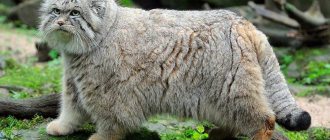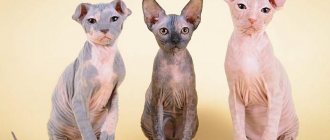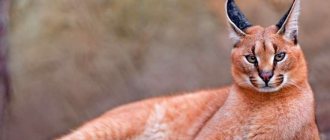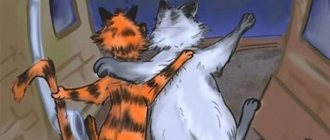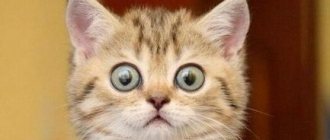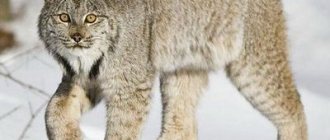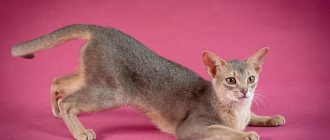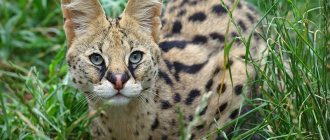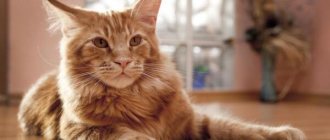The Norwegian Forest is an attractive semi-longhaired cat that combines physical strength, an energetic temperament and a gentle disposition. The playful owner of a thick, luxurious fur coat is not prone to destructive mischief and easily adapts to apartment conditions.
To make living together with a native of the harsh Scandinavian forests comfortable, it is better to find out in advance what the specifics of this breed are.
Key facts
The impressive size of the Norwegian Forest Cat, as well as its natural grace, attracts attention at any exhibitions and shows. Indeed, these animals can be very large; the weight of adult individuals can reach 10 kg. Females are slightly lighter than males, but can also weigh up to 8 kg. The description of the Norwegian Forest Cat breed highlights its size as an advantage.
The country of origin of forest cats is Norway, where their other name is common - stogkatt. The popularity of these giants is explained not only by their appearance: they are also very delicate, have a stable psyche and high intelligence. The Norwegian Forest Cat will not pester you with excessive communication, but will accept affection and attention from a person with gratitude.
These pets will easily live in families with small children, but they are also suitable for an elderly couple, as they have a calm character.
Longevity is considered a special characteristic of the Norwegian Forest Cat. Due to its good health, the life expectancy of the Norwegian forest cat is on average 15-20 years.
Nutrition
In terms of food, the forest cat is also a gourmet and a glutton: he prefers to eat fresh prey; his daily diet can consist of a dozen small rodents. An adult can consume up to a kilogram of food daily.
The victims of cats are:
- field mice
- Sony
- partridges
- pheasants
- coots
- gray rats
- muskrats
- trout
- nutria
- rabbits
- moles
- squirrels
- shrews
- caresses
- martens
- lizards
Once upon a time, cats living in the steppe regions caught bustards and even eagles; sometimes a large individual can defeat a small roe deer. Predators living on the banks of rivers and the inhabitants of floodplains hunt for fish and aquatic animals.
When approaching human habitation, cats free the surrounding area from the rodents that have settled there. While helping people in this way, they are doing harm at the same time by eating poultry. They cause harm to wildlife by destroying rare birds in protected areas (for example, in the Caucasus).
The meal process resembles that of an ordinary cat, but the front paws do not fall to the ground. It chews its prey, biting off one piece at a time, starting from the side of the carcass.
History of the origin of the Norwegian forest cat
The name of the breed itself indicates the origin of the cats. Indeed, they originally appeared in the forests of Norway. It is not known exactly when these beauties became pets. But many breeders point to the 16th century as the starting point.
It was at that time that Angora cats were brought to the countries of Western Europe from Ankara. The harsh Scandinavian climate, as well as the need to escape from wild animals in the trees, led to the appearance of thick undercoat, powerful muscles and strong claws.
Another theory dates back to the 9th-10th centuries, when the Vikings who participated in raids on the Shetland, Orkney, and Hebrides islands brought wild Scottish cats to their homeland. They were able to easily adapt to life on the new land, slightly changing their appearance.
From the 19th century to the first half of the 20th century, Stogkattas were common as pets in Sweden and Norway. In the 30s of the last century, they made their debut at the international cat show in Germany. Breeders were amazed by their data and began breeding work to improve the cat's natural qualities.
With the outbreak of World War II, this work was threatened due to uncontrolled crossing of animals with other cats. After the war, only owners whose animals fully met the breed standards could participate in the breeding of forest cats.
Thanks to the Norwegian Association of Cat Fanciers, the number of pets was restored. In 1977, the Stogkatt breed received official registration with the International Cat Federation.
Such recognition throughout the world made it possible to begin exporting the Norwegian forest cat to other countries. Currently, these giants have become widespread in many European countries, including Russia. Overseas, namely in the countries of North and South America, Norwegians create great competition for Maine Coons. Every year the population of purebred forest beauties continues to increase.
What does a Norwegian Forest cat look like?
What does a Norwegian Forest cat look like? This is an amazing animal with the most luxurious fur. Proportion, grace and strength are the features that catch your eye when you first look at a photo of a Norwegian forest cat.
Muzzle
The stogkat's head has the shape of a triangle with equal sides, but with fairly smooth outlines. The pet's profile is straight, the forehead is high and almost flat. The cheekbones are proportionally straight and also elongated. They are not clearly expressed.
The cat's nose is medium length and pink. The jaw part is massive. The chin can be square or rounded.
The inquisitive eyes of the Norwegian cat are very expressive. They come in oval or almond shape. When looking at the animal, a slight slant is visible. The most common eye colors are green or golden. However, other colors are not a deviation from the standard. For these animals, heterochromia or eyes of different colors are allowed.
The ears, wide at the base, have rounded tips with small tassels at the end. The ears are of medium size. They are located at a great distance from each other. The outer edge is a continuation of the line of the skull. The inside of the ears is covered with long hair.
Body type
The rather elongated body of the Norwegian forest cat is massive, with powerful, heavy bones. The cat's muscles are highly developed. The chest is wide and round in shape. The back is strong, and the rear of the body is located slightly above the shoulder line.
The forelimbs are long and strong, standing parallel to each other. The hind limbs look much longer and more massive. The pet's hips are powerful, with strong muscles. The paws are oval or round in shape. The pads are dense. The toes are well developed, with tufts of thick hair in between.
The long tail curves well and, when bent, reaches the shoulders or neck. It is located high at the level of the body. The base is quite wide with a narrow tip. The tail is very bushy.
Coat and color
The coat of the Stogkatt is semi-long, but very thick. The undercoat is fluffy, somewhat wavy. The guard hairs are covered with an oily, water-repellent substance, which can make your pet look less than neat.
The chest and neck parts are decorated with long hair, similar to a mane. Cute fluffy pants are visible on the hind legs. Tufts of hair should be on the tips of the ears and between the animal's toes. However, among the exhibition winners there were individuals without such characteristic decoration.
The color of the Norwegian forest cat is very diverse. On average, there are about 64 types of animal shades. However, different national organizations have their own standards.
For example, the International Federation allows solid, bicolor, smoke, shaded or tabby colors, but does not accept tan or light brown, which are often found in Burmese cats.
The French Society of Pedigree Animal Lovers rejects chocolate-colored, lilac-colored, and color-point Stogkatts. Varieties of the Norwegian forest cat are not distinguished.
Appearance
The characteristic features of a predator are expressed most clearly in cats, because they are more adapted than others to pursue and defeat living prey. Their long, flexible body combines strength and agility, which are so great that the largest species are able to kill and drag over long distances animals that are significantly larger than them.
Forest cat teeth
The main distinguishing features of living cats are very short jaws, a small number of teeth, strong development of canines and carnivorous teeth, highly curved, retractable claws and mobility of the forelimbs.
The function of the carnivorous teeth of the forest cat is reduced to cutting food more than that of all other predators; they do not have any devices that would indicate the ability to chew or crush food, they are simply halves of scissors or knives.
The remaining molars are no more suitable for chewing, so the entire dental system of living cats is fully adapted to grasping prey and cutting its meat.
The fangs are very long and strong and are armed on their back surface with a sharp edge, like a blade, making it easier for them to penetrate the body of the victim. On the other hand, incisors and false roots do not play a big role.
Cat legs
All cats have five-toed front legs, and four-toed hind legs; the claws, on both of them, are strongly curved, sharp and, with the exception of cheetahs, can be retracted into the vagina that protects them. To keep them clean and sharp, most cats have developed the habit of scratching tree trunks with them.
When walking, cats step exclusively on their toes, and the heel becomes vertical and seems like a direct continuation of the rest of the leg. However, the first, i.e., inner, toe of the front leg does not touch the ground and thus does not support the animal when walking. On the hind leg, as we said, there is no such toe at all.
The crumb of each finger is like a pad, but the same pads are located on the sole of the foot and between the toes; in addition, there is an extra pad on the front leg. When walking on these elastic elevations of the sole, animals walk quietly and silently, and retract their claws.
As a result, the tracks left by cats are easily distinguishable from those of dogs, which always have a claw imprint.
Cat tongue
Cats also differ from dogs in the structure of their tongue. Smooth in dogs, it is lined with a large number of flat, backward-directed horny papillae in cats, which turn it into a very effective grater.
This arrangement of the tongue helps the cat to lick, tear off meat from bones, and maybe use it to clean its fur coat, which dogs are so little occupied with. The cat eats only soft food and cannot chew or swallow bones.
Forest cat fur
With the exception of the male lion, which is known to have a long mane, the fur of the forest cat consists of hair, the length of which is more or less the same on all parts of the body. This hair can be either shorter or longer depending on the climate in which the known cat species lives. Thus, in the northern leopard it is always longer than in its southern form - the leopard, and in the tiger, found in both hot and cold countries, it is subject to changes in length.
Mustache
Among cat hairs, whiskers are especially characteristic of this family. They are innervated by special nerves, due to which they represent excellent organs of touch that provide great services in the nocturnal adventures of animals.
Eyes and tail
The nocturnal lifestyle of cats is also indicated by the structure of their large eyes, the pupil of which can be enlarged or reduced by contracting or spreading the iris, depending on the brightness of the light at a given time.
The tail of most cat species is long, it is capable of producing snake-like movements, which are especially often observed in cats that are excited or chasing their prey.
Color
Some cats, such as the lion and the cougar, are more or less uniform in color, but probably all newborn cats, with the exception of domestic cats, and many species wear a spotted or striped outfit as adults.
The striping can be longitudinal or transverse, and the spotted pattern is sometimes irregular, sometimes the spots in it are collected in longitudinal or transverse rows. Among some species of cats, black individuals are also found as an exception, for example in the Asian panther.
In terms of height, cats vary more than other predators; indeed, while the lion and tiger are surpassed in height only by some bears, the smallest member of the cat family is smaller than our ordinary domestic cat.
Personality of the Norwegian Forest Cat
Stogkatts, like true Scandinavians, have a balanced, calm character. They rarely show any emotion, be it joy or aggression. It is important for them to have personal space, the boundaries of which not everyone is allowed to violate.
Since animals lived in the wild for many years, they are genetically endowed with a desire for free life. Therefore, it is quite difficult for them to live in a city apartment, especially if there is no opportunity for independent walks in the fresh air.
A country house would be an ideal place for a forest giant to live. He will have a good opportunity to display wild instincts. Reviews from Stogkatt owners indicate regular manifestations of wandering syndrome. Indeed, representatives of the Norwegian forest breed are characterized by long disappearances from the owner’s field of vision. Such walks can last from several hours to a couple of days.
On the other hand, a freedom-loving pet will show great dissatisfaction if it is left alone for a long time. Norwegians do not tolerate loneliness well; they are more comfortable knowing that a loved one is somewhere nearby.
Despite their brutal appearance, forest giants are very friendly creatures. They get along with other pets easily. They will not quarrel with them for territory or a tasty morsel, but the attention of their beloved owner should belong only to them.
Cats have a good relationship with small children. Norwegians most likely will not want to take part in games with the guys, but they will not bite or scratch if they get intrusive attention from them.
Possessing an extraordinary mind, as well as high intelligence, pets will not obey the whims of humans. They are able to make their own decisions, so it will not be possible to persuade them with words or treats.
The inquisitive nature of the Norwegian forest cat forces the animal to always be aware of what is happening in its habitat. They should definitely look into the new bag or box. Stogkatts are even able to inform their owner about any problems. For example, they will definitely let you know if a tap is not closed somewhere.
The impressive size of the animals is combined with a quiet voice. Therefore, they will not cause inconvenience to neighbors or members of their family.
Breeding
Representatives of any breed that originates in the wild have highly developed instincts for procreation and preservation of offspring. These instincts continue in the home environment. Often domestic cats do not need help with either giving birth or raising kittens. But a lot still depends on the breeder. The owner of a purebred cat must find a suitable partner and ensure mating. Usually the owner of a Norwegian tries to meet his future partner personally. Sometimes you even have to go to another city to do this.
Even a non-professional breeder can cope with breeding Norwegian cats
If the cat is purebred, then the cat must match. And age, I think, is not the main thing, you can be younger, the main thing is that the cat is experienced.
vikatiras, forum regular
https://pro-cats.ru/forum/74–4262–3
Criteria for choosing a partner
Inexperienced cat breeders are looking for equally beautiful partners for their Norwegian cats (often also Norwegian). In this case, only the appearance of the cat is assessed (less often, purebred). But the owner of a potential partner may be more experienced. In this case, the cat may not be provided for mating. Few people would want to mix a titled cat with a non-purebred cat. Therefore, before you start choosing, you need to learn how to evaluate the possibility of mating. The likelihood of consent from the partner’s owners and the health of the offspring depend on this. There are 4 main criteria:
- pedigree;
- appearance;
- color;
- blood type.
The most difficult thing about breeding Norwegians is finding a suitable partner
It is not necessary to look for the ideal representative of the breed, you need to find a suitable partner. The presence of titles and regalia does not guarantee the birth of beautiful, healthy offspring. In order for kittens to be as beautiful as their parents, it is advisable to choose a partner who is as similar as possible to your cat. This may be an individual from the same breeding line. Such an animal can be found from the same breeders where you got your pet. When mating relatives, beautiful kittens should be born (provided that the parents are outstanding representatives of the breed) with a good phenotype. This mating is called inbred.
Some forest cat owners are afraid of related matings, and sometimes it is difficult to find a partner from the same pedigree in the right city. In this case, you can choose a partner based on appearance. It is necessary to evaluate the advantages and disadvantages of appearance (head shape, coat quality, distance between ears, etc.). But this method is convenient to use for those breeders who have already learned to distinguish the characteristics of the breed. If you don’t have such skills yet, you can ask the owners of a potential partner for an assessment sheet. This is especially appropriate if you want to adjust the breed of future kittens. For example, if your cat has weak and slightly dull fur, then the cat’s hair, on the contrary, should be ideal.
If you do not have experience mixing cats with different colors, then you need to look for a partner of the same color as your cat. This will increase the likelihood of having kittens with high-quality color. It is also important to take into account the pattern on the animal’s fur. You cannot mix a marbled specimen with an animal, for example, black and white (bicolor). From such a mixture, kittens of both colors can be born, but the pattern will be of poor quality. Marbled kittens may have black or white spots, and black and white babies may have vague patches of merle color. Such nuances are called color defects. It will be difficult to sell such kittens (but you can give them to friends or keep them for further breeding).
In order for the kittens to turn out beautiful and similar to their mother, it is advisable to look for a partner of the same color as her
Cats can have one of three blood types (A, B and A/b). They also need to be taken into account. Cats with group B can be crossed with any cat. And females with the same blood group cannot be mated with males of group A. If this rule is violated, kittens may be born with a disease such as hemolysis. If a cat with blood type B gives birth to kittens with type A, then the offspring must be taken away from the mother immediately, otherwise they will die (after living only a few hours). The babies will have to be fed artificially for three days. The surviving kittens will not be able to become champions of the breed, since after illness the tip of their nose will fall off. To avoid such troubles, you need to know your pet's blood type in advance. The corresponding tests can be done in special laboratories (they are not available in every city).
At what age should you give your pet for the first mating?
Full maturation of a Norwegian cat will occur around the age of 5. Therefore, there is no need to try to mate a young cat. But I also don’t want to wait 5 years, so the first mating can be organized in 2–3 years. If a cat lambs before this age, then its growth and development may “freeze.” She will not grow any further, which means she will look much smaller than her adult relatives. Males can be mated as early as one and a half years old.
A female with a Nordic character will not allow just anyone to approach her. In general, cats of this breed may avoid any communication with other people's animals. But the male, already in adolescence, will “molest” all the cats he finds nearby (including cats of other breeds and outbreds). Kittens can be born beautiful hybrids, but that is not the problem. Someone else's cat (especially a mongrel cat) can infect your cat with some kind of disease. Therefore, a cat that goes outside needs supervision.
Before mating, both individuals must undergo helminthiasis prevention. The procedure for mating a Norwegian cat takes 3–5 days. But even before mating, the owners of both animals can agree on a reward (this is not necessary). If the mating was successful and the cat became pregnant, then the owner of the male is entitled to a kitten from this litter or money (equivalent to the amount of one kitten). Particularly experienced breeders can even enter into written agreements with each other, which will describe in detail all the terms of the transaction.
Video: Norwegian cat courting a female
How often can a cat give birth?
If the owner of the female does not control the frequency of births and does not provide organized mating, then the cat can give birth 3-4 times a year (maximum 5 times). Frequent pregnancy and childbirth can lead to illness in your pet. The fact is that the body of cats that often give birth weakens and does not have time to recover. If there is too little time between births, the following problems may occur:
- weight loss;
- rachiocampsis;
- disturbances in the functioning of the nervous system;
- respiratory tract diseases;
- diseases of the reproductive organs;
- hepatitis, necrosis, etc.
A tired cat has a weakened immune system, which means there is a risk of catching some kind of infection. For these reasons, you should not turn your furry cat into a birthing machine. In addition, mating is an expensive undertaking in itself (sometimes the partner lives in another city). Typically, breeders breed their forest cats 1–2 times a year.
Raising a Norwegian Forest Cat
Norwegian forest cats are rightfully classified as intelligent animals. They are very independent in making decisions, they can analyze the situation and draw conclusions.
Raising a small cat begins at an early age. As soon as the kitten appears on the doorstep of the apartment, you should accustom it to the rules of behavior in the house. You need to start by using a tray. For the first few weeks, he is taken to the area where the toilet is located, encouraging independent attempts.
Usually babies learn to use a scratching post pretty quickly. To get used to it, you need to show it every time the cat has a desire to scratch the objects around it.
Stogkatts are well versed in their owner's intonation, so there is no point in shouting at them. You just need to express your dissatisfaction or approval of any action in a calm voice. You should not physically punish your pet, otherwise he will harbor a grudge and then he will definitely not do anything.
Health of the Norwegian Forest Cat
Possible diseases
The result of long natural selection was the formation of a strong, healthy Scandinavian breed. Subsequent human intervention did not leave a very good mark on the genetics of forest giants, but they continue to be considered hardy animals.
The health of the Norwegian Forest Cat is stable, but unfortunately, there are diseases to which they can be susceptible:
- restrictive cardiomyopathy, which causes a decrease in the elasticity of the heart muscles, subsequently leading to chronic heart failure;
- diabetes mellitus of various types, provoked by disruption of the functioning of the endocrine system due to insufficient production of insulin;
- arthrosis of the femur is a chronic joint disease that can develop at any age of a pet;
- retinal dysplasia due to improperly formed layers of the retina during fetal development;
- chronic renal failure, caused by an often irreversible decline in kidney function;
- glycogenosis type IV - a hereditary disease that disrupts the functioning of the liver and causes the development of cirrhosis of the organ; such animals are often born dead or do not live up to four months;
- pyruvate kinase deficiency, in which the number of red blood cells is dangerously reduced and anemia occurs.
If such diseases are detected, breeders do not use the parents of kittens for further reproduction of offspring, thereby creating conditions for the birth of healthy babies.
Vitamin and mineral complexes help maintain animal health at a high level. However, you should not choose them yourself - you must buy tablets on the recommendation of a veterinarian.
The first vaccinations are given at the age of 6-8 months, repeated complex vaccinations are carried out at six months. In the future, a similar procedure is performed annually.
With proper care, regular visits to the veterinary clinic, and the necessary physical activity, Norwegian forest cats live a long time, maintaining a clear mind and high activity.
Reproductive health
The physical development of females ends by the age of four. However, the first mating can be carried out after two years of life. Earlier pregnancy leads to a weakening of the animal, a slowdown in its development, as a result of which the offspring appears weakened, and there is a high risk of congenital diseases.
In healthy and mature cats, childbirth occurs without any complications. On average, a litter consists of three to five kittens.
The first estrus in females occurs quite late, which is due to the large size of the breed. Sterilization or castration is recommended at the age of 1 year. These procedures improve the pet’s standard of living and increase its duration.
Features of feeding and diet
Nutrition is an important aspect in the life of Norwegian giants, as they expend quite a lot of energy. A truly large pet requires a large portion size. The feeding rate is determined by the weight of the animal, its physical activity, and age.
Feeding a kitten begins at 1 month of age. To begin with, food should be four times a day, from 4 months they switch to three meals a day, and from 6 months onwards it is enough to feed the pet twice a day. It is important not to overfeed your Norwegian to avoid causing obesity or food allergies.
A cat's diet needs to be properly balanced. In this case, the food can be natural, industrial, or a combination of these two types of food. When using dry and wet industrial feeds, you need to purchase premium professional brands. They contain all the beneficial substances cats need, while their cheap analogues can cause irreparable damage to the pet’s health.
Natural nutrition should contain a fairly large amount of protein, a minimum of carbohydrates and be enriched with vitamin and mineral complexes.
The basis of the stogkatt diet is lean meat products: beef, veal, chicken, turkey, and offal. Low-fat dairy products and cottage cheese are given not only to kittens from one month of age, but also to adults. It is useful to add boiled and chopped vegetables to your cat’s menu. The most useful for them will be pumpkin and carrots.
From cereals, you can sometimes give oatmeal porridge cooked in meat broth.
For any diet, prohibited foods include:
- sweets;
- berries and fruits;
- flour;
- tubular bones;
- River fish.
You should not encourage your pet to beg. Having given in once, it will be difficult to wean him from this bad habit.
As a source of vitamins, it is recommended to sprout in pots and treat the animal with tender green oats or wheat. They contain substances necessary for the proper functioning of the Norwegian gastrointestinal tract.
Care and maintenance
Due to their large size, the most convenient place to live for Norwegian pets will be a country house with its own plot. It is there that the giant will be able to develop his physical abilities and get the opportunity for long walks. It is quite difficult to do this in a city, given the dangers in the form of highways or stray animals. Therefore, a cat living in an apartment must be walked several times a week on a special harness that will prevent escape.
Representatives of the forest breed have a natural desire to conquer tall trees. Owners of city apartments should definitely buy a special cat tree with a wide platform at the very top. Sitting on it, the animal will be happy to watch what is happening around.
Furry giants require the same careful care as other long-haired individuals. Stogkattas require moderate grooming, because by standards they have a wild exterior. But you need to comb them daily. Using a wooden comb as well as a brush with natural bristles will help prevent tangles from forming.
Cats should only be washed if they are heavily soiled or before participating in exhibitions. For washing, use a special shampoo for long-haired animals, washing the hair at least twice. The oily composition covering the individual does not allow water and detergents to pass through easily. After bathing, hair should be dried and conditioned to prevent tangling.
If the cat lives at home without frequent walks, then his claws should be trimmed. The first time this procedure should be performed by a professional, and then you can do the manicure yourself. To do this, you will need to purchase a special nail clipper and nail file. It is important to cut off no more than 2 mm of the tip of the nail plate so as not to harm the Norwegian cat.
Occasionally, but at least once every two weeks, wipe the pet's eyes and ears with a cotton pad or cotton swab moistened with special solutions.
In apartment conditions, a tray with large filler is used for pet toileting. Small particles will get stuck in large paws and cause discomfort. You need to place a rubber mat in front of the tray, which will help the cat clean the pads. You can buy such a thing at pet stores.
Overall, caring for and maintaining a Norwegian Forest Cat will require effort and time, but you will have a luxurious, amazing pet living in your home.
Characteristic diseases
It is easy to guess that the Norwegian forest cat has good health and a resilient immune system. Perhaps, precisely because the domesticated version of animals also has in its blood the genes of predators who had to live in harsh conditions of the natural environment. Only the most persistent and strong individuals can conquer Norwegian climatic conditions. So, even domestic Norwegians are physically resilient and strong.
The only characteristic genetic disease is called glycogenosis (type 4). Babies born from a cat with this disease may die immediately or after a couple of months.
The risk of developing and hereditary transmission of the disease in Norwegian Forest cats is lower than, for example, in Maine Coons, but it still exists. There is a high risk of developing heart problems (hypertrophic cardiomyopathy), which plague large felines.
Another disease that is relatively common, but not hereditary for Norwegians, is urolithiasis. If you want your pet to live the required 15-17 years, find out more information about the diseases we list.
Tips for choosing a kitten
Purchasing a purebred Norwegian cat in Russia will not be difficult. However, you should not completely believe advertisements on the Internet from private owners. A real forest cat can only be offered by professional breeders and specialized nurseries.
In any case, before purchasing, it is worth checking the documents about the pedigree of Norwegian forest kittens, looking at the parents themselves and the conditions of their keeping.
The requirements for the future pet itself are as follows:
- activity, curiosity;
- a good appetite;
- absence of skin diseases or parasites;
- pink gums;
- clean ears and eyes.
Before you finally make a choice, ask when the vaccination was carried out and whether the baby has a veterinary passport.
Purchasing a kitten
As a rule, wild cat kittens are born healthy and strong. They become covered with outer coat at the age of three months, but become fully grown by the age of five. Buying a Nordic kitten is difficult. There are many advertisements on the Internet and newspapers about the sale (or gift) of these babies, but it is almost impossible to verify the purebredness of their breed. But if you need a kitten for yourself (for the soul), then you can resort to advertisements. But if purebredness is extremely important (for example, for breeding), then it is better to contact either professional breeders (and there are few of them) or a nursery. The fact is that nursery employees and volunteers are not interested in deception, so the risk of being deceived is minimal.
Norwegian kittens are very similar to their parents (they can be identified by the shape of their eyes and the length of their paws)
Such a kitten can cost up to 25,000 rubles. The price depends on several factors:
- purity of the breed (with pedigree is more expensive);
- coat color;
- city (large cities are more expensive);
- prestige of the nursery.
If a kitten is bought second-hand, then the price can range from 1000 rubles and more.
Criterias of choice
When choosing a Norwegian baby, you need to pay special attention to the following criteria:
- age;
- health;
- behavior;
- pedigree;
- health of the nurse cat.
It is advisable to adopt a kitten at the age of three months. First, you need to wait until the cat has taught her baby everything (use the litter box, eat, play, etc.). In addition, primary immunity is instilled in the baby with the cat's milk. The exception is if the kitten has lost its mother, and feeding her with milk is already impossible. And secondly, up to three months the kitten is vaccinated. If the baby is of suitable age, you need to examine the animal. He must be active, clean, without any damage to the coat or skin. Some are guided by the rule “the kitten chooses its owner.” If a cat rushes into your arms, this may be just such a case. Pay attention to the documents. A purebred Norwegian must have a pedigree. The more ancestors of a cat are known, the better. Finally, examine the cat. A healthy cat has a healthy kitten. Naturally, you can make a discount on feeding. Mommy may be a little lethargic and her coat may be slightly dull.
